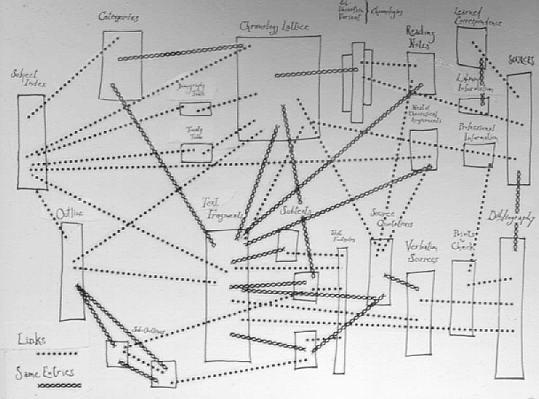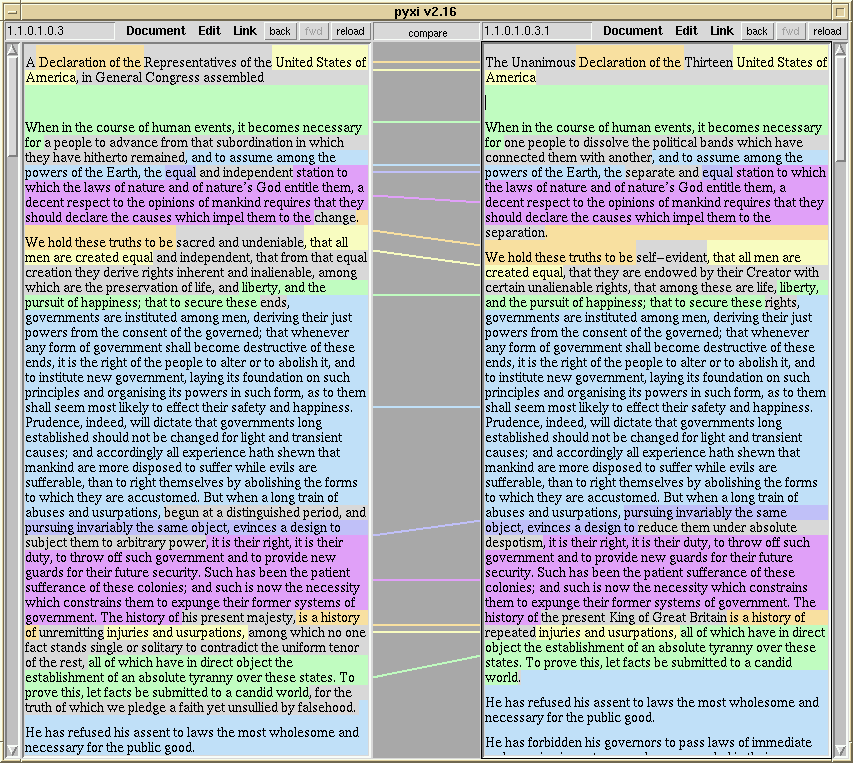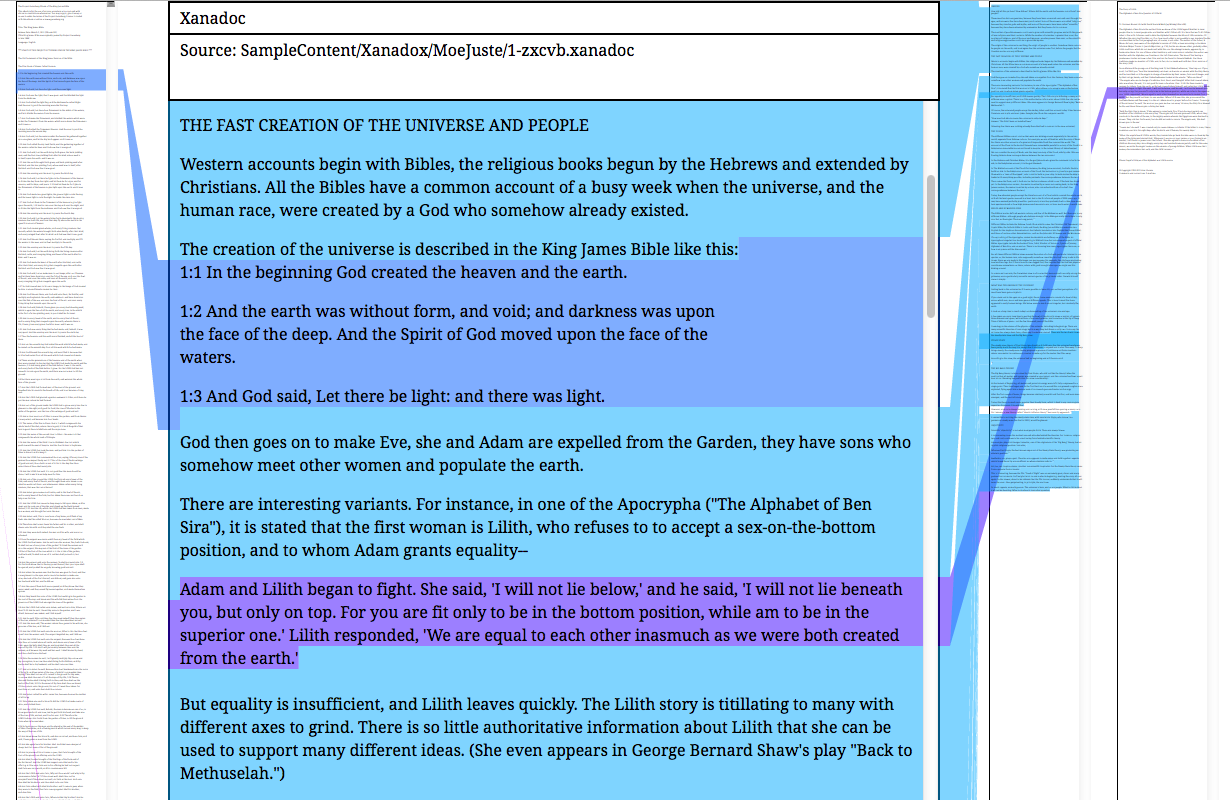Malleable Systems Collective
Catalog with resources, projects, papers on malleable software, e.g. user-tailorable systems, end-user programming and similar principles.
Catalog with resources, projects, papers on malleable software, e.g. user-tailorable systems, end-user programming and similar principles.
http://website-with-the-sound-of-its-own-making.net
(After “Box with the Sound of Its Own Making” by Robert Morris, 1961)
“This web application accesses the source code of the website and interferes with its logic. Each time it is implemented by a unique combination of methods. The algorithm performs about 1000 interventions per second, using 369 151 937 methods.”
Some links to notes and approaches on end-user programming, or the idea of software as programming environments fundamentally composable by users.
“PANE is a live, functional programming environment built around data-visibility. In PANE, all intermediate values are visible by default, and you construct a program by acting on these concrete values.”
“Single pages from IKEA furniture-assembly instructions were mixed together and renumbered. The result is an instructions manual of about 700 pages.”
https://ggor.de/en/project/baebel/
And other of his projects:
https://ggor.de/en/project/
“PROGRAMMING LANGUAGES AS EXPERIMENTS, JOKES, AND EXPERIENTIAL ART
esolangs, disruptive codes, weird hc/i, differential thought platforms, the digital ephemeral, null programs and deletions, unstable linguistics, structure as content, machine disobedience, new relationships between programmers and their primary progeny (bugs), useless machines (Shannon/Minksy), synthetic languages, circuitous systems, constraint sets for coders, paraconsistent calculi, and other platforms, systems, and languages that break from the norms of computing”
“In computation, a ’pipe’ is a method to enable various software modules to connect to each other, where the output of one program is treated as the input for the next program. ’Pipes’ form the basis of The Unix philosophy, a perspective on software production where multiple task-oriented tools can be chained together to make seemingly endless software combinations possible. While interchangeable and flexible, the assumption that each element should be optimised to ’Do One Thing and Do It Well’ leads to a rather predictable and ultimately normative set. If each tool is designed to be used in any context by anyone at any time, what about situated knowledge? How can we imagine modularity, knowing that software processes are inherently leaky and contextual?”
“Automatic.ink is a platform for algorithmic literature. Automatic.ink was designed around the following question : “What would an algorithmic literary writing tool look like?” … Many excellent “e-lit” tools, languages and libraries already exist for algorithmic literature (cf. Twine, RiTa, Fungus, …). Many of these tools, however, do not focus on the writing act, and require using development tools during the actual process of writing. … For the Automatic.ink platform, we instead focused on a writing tool that a poet might find compelling, and would therefore evolve out of an interface dedicated to the modular written word. As the research project evolved, our goal slowly evolved into a writing tool for text-based algorithmic literature, associated with a “programming language for poets” named AutomaticWriting<>.”
“… is a hybrid graphics editor and programming environment for creating interactive diagrams.”
Group project to develop a new software system based on Doug Engelbart’s ideas for the 50th anniversary of the demo of 1968.
http://ualr.edu/jdberleant/URLtable-DB.html
http://dkr.space
http://doug-50.info
http://timebrowser.info
“Queer Programming Anti-Language”
Early spreadsheet software, to be considered the first “killer app” for Personal Computing and the first application that convinced people to invest in whole systems (the Apple II). First software that went through a whole software career cycle, until its decline fueled by competitor “Lotus 1-2-3”. Also notable for its good documentation at that time.

1965, Side-by-side connected comparison of parallel documents

1999, PYXI viewer by Ka-Ping Yee

2014, OpenXanadu by Ted Nelson and Nicholas Levin
Key concepts
Xanalogical structure
Parallel documents / Transpointing windows
Annotation
Deep links
Deep versioning and re-use (transclusion)
Xanalinks
Stretchtext
Intertwingledness
Links
http://ted.hyperland.net
http://xanadu.com/xUniverse-D6
http://xanadu.com.au/ted/XUsurvey/xuDation.html
http://xanadu.com/XUarchive/htn8.tif
JS implementation of Stretchtext
ZigZag database system
“Entropy is a programming language about giving up control. All data decays as the program runs: each value alters slightly every time it’s used, becoming less precise.”
http://danieltemkin.com/Entropy
Also “New Languages”
http://danieltemkin.com/Esolangs/
“The objective of allRGB is simple: To create images with one pixel for every RGB color (16777216); not one color missing, and not one color twice.”
Wireless sensor stickers for context aware applications. Considering the fundamental messiness of infrastructures and the procedural simplicity of the functional programming I imagine some interesting side effects if these things move around unintentionally, become trash and create a messy hyper-context, where you loose sight of what reacts to what. Maybe a question of context-aware ubiquitous applications in general.
“Scream sits quietly in your computer’s system tray and automatically springs into action when it detects a scream. Scream disturbs your Windows interface. […] When your throat gets tired, Scream can double as an unusual music visualizer – or as a new approach to desktop filmmaking. Use Scream to start a meme. Or simply as a random act of deprogramming.”
Talk demonstrating the concept and prototype of a software tool for creating parameterized graphics. Blend of programming and graphics.
“We worry about the imaginary, supplemental alphabets starting with letter twenty-seven. This is the impulse behind our notes for a liberated computer language, to re-introduce new noisy alphabets into the rigid semantic zone of informatic networks. […] We consider there to be little difference between living informatic networks and the universal informatic languages and standards used to define and sculpt them. If the languages are finite, then so, unfortunately, are the life possibilities. Thus a new type of language is needed, a liberated computer language for the articulation of political desires in today’s hostile climate of universal informatics.” (“The Exploit: A Theory of Networks”)
“… camera and monitor function as a mirror that links the images of the viewers. […] The software, which runs between camera and monitor, attempts to re-construct each face from image fragments of the other. The image of one face cannot be realised without the other and vice versa.
See also other works about materiality, aesthetics and potential of digital technologies:
http://www.rlfbckr.org/
Machine generates shapes and tries to recursively imitate them, creating an endless process of effort due to the inevitable tolerances.
…is comprised of over 2,000 voice recordings collected via Amazon’s Mechanical Turk web service.
Questions digital tools in the design process, relationship human and machine, freedom and limitations. She designes systems with defined limits and rules to create space for unexpected things (Conditional Design Collective).
Other topics: creation of own digital tools, co-design with algorithms, man-machine-friction/-adaption, productive glitch and space for imperfection in digital technologies.
http://poly-luna.com (see interview e.g.)
The names of the victims of the terror attack on the memorial site are ordered with the help of custom software by their relationships (family, friends, colleagues together). Relatives could influence the final layout. The arrangement should reconstruct the “social net” of the victims.
Collaborative online development of animations with alternative narrative paths. Tree as interface metaphor.
“…combinations of image and text from different authors, linked by a place on earth – fragments of a collective local memory.”
A trading algorithm based on superstition (moon phases, numerology). An objectively subjective apparatus.
“This book contains the first Google image result for every word in the dictionary.”
Digital image atlas following ideas of Aby Warburg and Walter Benjamin, focused on objects of non-western culture. Not very rich of material.
“…for the display an open number of artifacts, objects and positions that may enter via an edited matrix of attributes into variable, unpredictable, and dynamic relations with each other.”
“A myriahedron is a polyhedron with a very large number of faces. For this reason, we call the results myriahedral projections. In step 2 and 3, this myriahedron is cut open and unfolded. The resulting maps have a large number of interrupts, but are (almost) conformal and conserve areas.”
Research project about the possible role of networked images in the sciences. A system to assamble, categorise, annotate and link images wants to explore new forms of working with images in other scientific contexts than in art history. Some examples on the website.
Translates barcodes in output signals on an array of power sockets, where you can connect all kinds of electronical devices.
Generative compositing technique. Different moments in time composed in a video grid.
http://www.creativeapplications.net/
http://vimeo.com/26938422
A collection of 250 situations / scenarios / pattern of problems in architecture and urban planning. Images, texts and diagrams explain each situation and propose solutions. Structured in three parts from macro to micro (towns, buildings, construction). Meant as an instruction of modular solutions with the effort to enable more lively, integrated and beautiful architecture.
Tool for drawing with tagged video content to create a dynamic networked image.
Strong usage of generative techniques and self made tools in graphic design projects. Co-responsible for Scriptographer.
Algorithmically extracted and combined elements of architectural photographs creates new images/interpretations of spaces.